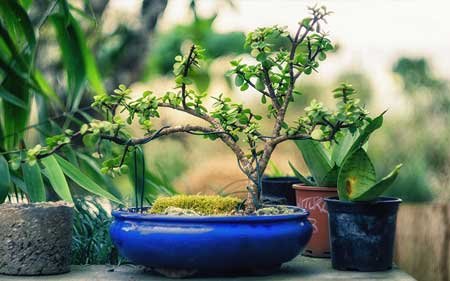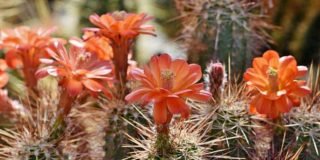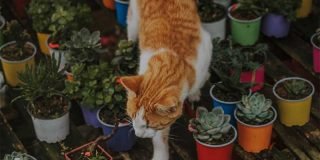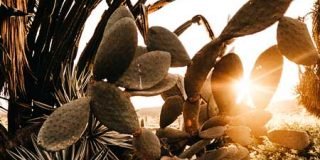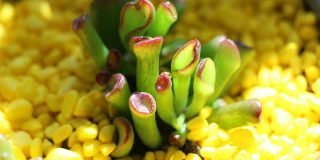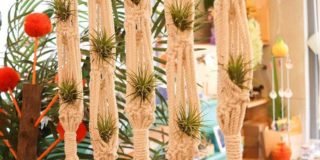Contents
Nowadays, there’s a growing interest in making bonsai succulents. It’s a rather uncommon combination, but bonsai succulents can be an exciting addition to your plant collection. So, if you’re looking for something new to try with your succulents, try applying bonsai techniques to your plants.
What is Bonsai?

The Japanese term bonsai means “to plant in a tray,” and that’s what bonsai practitioners precisely do. They recreate the shape and appearance of mature plants on a smaller scale. The typical bonsai plants are cultivated and pruned to maintain their miniature size and are shaped until they look like tiny versions of mature plants. The height of bonsai trees typically ranges from 6 inches to 4 feet.
What Makes Succulents Ideal for Bonsai?
If the common bonsai plants do not appeal to you, the good news is that succulents make ideal subjects for bonsai. There are several reasons why succulents are great for bonsai. Succulents are native to the arid regions with tropical and semitropical climates. Harsh conditions like growing in rocky soil, enduring unforgiving winds, inconsistent water supply, erratic daily temperature, grazing animals, exposure to full sun, makes them naturally small or dwarf-like.
The morphological features of succulents also make them ideal for bonsai. Their fleshy leaves, swollen stems, and thick bases enable them to store excess water for use during drought. Succulents are very appealing to bonsai lovers because of their exciting colors, varying textures, and dramatic leaf shapes.
Moreover, succulents adjust well to trimming and shaping, so you don’t have to worry about hurting your plants. You can even use the cuttings to propagate your succulents.
Succulents are relatively easy to care for, allowing you to maintain your new bonsai hobby despite your busy schedule. Because of the slow-growing feature of succulents, you will have plenty of time to plan out its shape and overall look.
Unlike most plants used for bonsai, succulents don’t need to have their roots trimmed and will do better when you leave their roots alone. Succulents usually grow in shallow containers, so there is little need for root trimming.
How to Make A Succulent Bonsai

Succulents with thicker foliage will allow more comfortable trimming without the risk of making your plants look thin and sparse. Other desirable features to look for are foliage texture, branch formation, unique habits, flowers, and fruits. Most importantly, choose a succulent that recovers well after a transplant and produces new growth after pruning.
Make sure to adhere to established bonsai recommendations when pruning your succulents to encourage Y-shaped branching and small, proportionate spaces between the stems and leaves. Pruning may prevent your plants from flowering in the following season, or until it has produced new growth.
Pruning the roots of succulents is generally not recommended. Their roots become less healthy after pruning, so it’s better to leave them as is. If you need to trim the roots for aesthetic purposes, remove all soil, and wait for the wounds to be completely dry before you replant. Moist on your succulents will cause it to rot, and significant cuts will need several weeks to heal.
Potting
Plant your bonsai in pots with drainage holes because, like most succulents, bonsai plants need a container that allows for adequate drainage. Cover drainage holes with non-clogging mesh pads or pot screens to prevent soil corrosion during watering.
Avoid planting succulents with different species in the same container because they may have different growing requirements.

When you trim your bonsai succulents into its new shape, imagine how you want your finished product to look like. Have an ideal image in mind, so you have a clear idea of which stems and leaves to trim off. Trim your succulents before their growing season. If your plant grows through the summer, start shaping it in the spring, and continue to do so as it grows more leaves.
Wiring
Your bonsai will continue producing leaves as it grows, so you will need to trim it to maintain your desired shape. However, your plant will struggle to stay upright once you’ve cut its lower leaves and branches. Help it stay upright by supporting it with aluminum wire. We recommend using these aluminum wires instead of copper because aluminum is more pliable for shaping, and the material is strong enough to support your succulents.
How to Care for Succulent Bonsai
Caring for succulent bonsai requires an understanding of their natural habitat, which varies from species to species. In general, succulents thrive in warm and well-lit environments. We recommend taking them indoors when the temperature drops below 50°F.
Succulents should have compact growth. Elongation of their stems and internodes are signs that they are not getting enough sunlight.
Overwatering plants are one of the most common reasons why succulents die. When watering succulents, drench it until water comes out of the drainage holes, then wait until the soil completely dries up before you water again. Cut back on watering during your succulent’s dormancy period. Do not water your succulent bonsai after repotting as it will cause root rotting.
Plant your succulent bonsai in fast-draining soil. Ideally, the soil should be a mix of aggregate, organic materials, and cinder for proper drainage and aeration. Fertilize it more often with smaller doses to promote slow and even growth. Do not fertilize your succulents when they are dormant.
Succulent Varieties that Make for Ideal Bonsai

Making succulent bonsai can be a rewarding hobby, and the products can increase the aesthetic value of your garden. Make sure to refer to this guide when you start making your succulent bonsai to avoid harming your succulents in the process. If you have any questions about making succulent bonsai, please let us know in the comment box below.
Eden Succulents strives to bring you comprehensive information about succulents. Please check the links we provided for the products that will help you enjoy growing and caring for your succulents.
Uncle Daves Pot Screens
- Keep Your Soil In & The Bad Bugs Out!
- One Size Fits All Pots & Planters!

